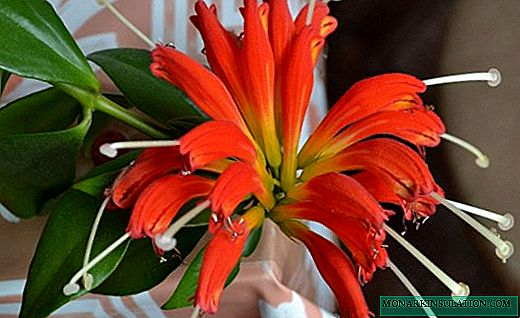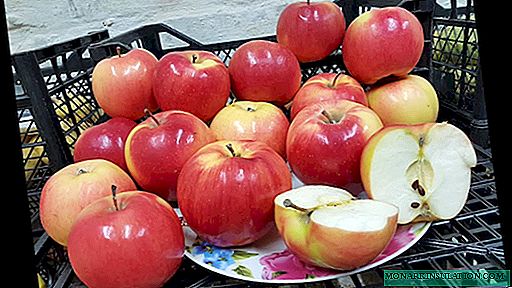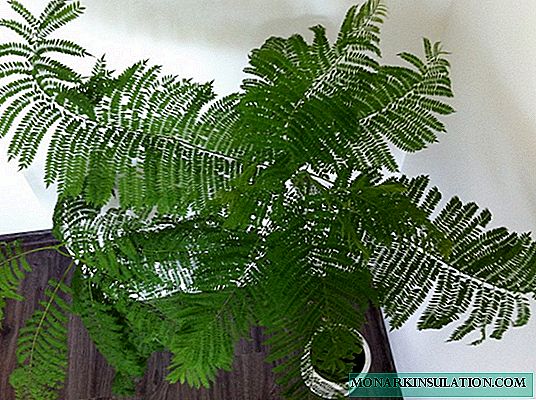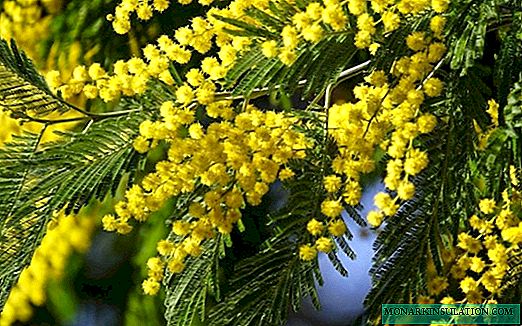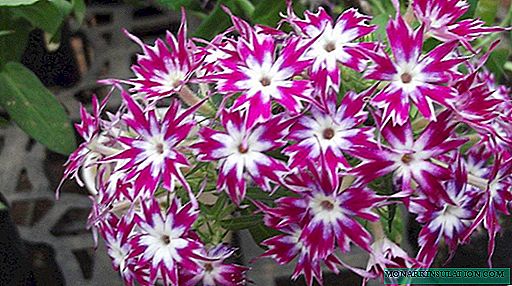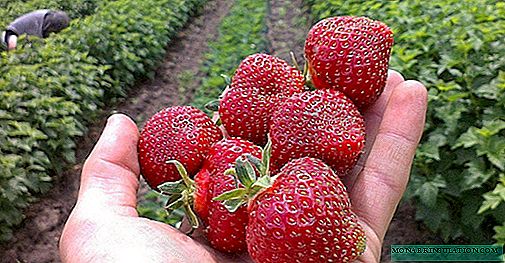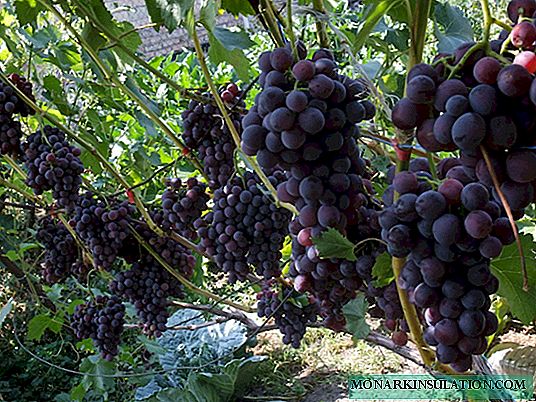
Today, grapes in our garden plots are as common a plant as an apple tree or a cherry. This culture is grown in the European part of Russia, in Siberia and the Far East. Therefore, it is not surprising that scientists in the world have already bred 20 thousand grape varieties, of which 3 thousand are grown in the CIS. Various publications regularly compile lists of the best of them. The lists always contain a table grape variety Kodryanka.
Origin of the Kodryanka grape variety
The variety was obtained by Soviet scientists in 1985 at the NIViV (National Institute of Viticulture and Winemaking) of the Ministry of Agriculture and Food of the Republic of Moldova. Codrianka was bred by crossing the popular varieties Moldova and Marshall.
The variety is often found under the name Black Magic (Black Magic).

"Parents" of Codrianka - varieties Moldova and Marshalsky
Grade characteristics
Kodrianka is a table grape variety. The berries are dark purple, elongated, the skin is thin, the flesh has a simple, moderately sweet taste. There are few seeds in the fruits, and they are easily separated. One berry weighs 9-17 g.

Clusters of Kodryanka keep excellently on a vine even in a ripe state
A ripe bunch extends to 400-600 g, and with proper care, its weight reaches 1.5 kg. The concentration of basic sugars is 8-19%, the acidity is 6-7 g / l, the tasting score is 8.2 points. The variety has a high resistance to mildew and gray rot; it is also tolerant (hardy) to phylloxera. Withstands cold up to -23 ° С. The bunch keeps well on the vine even in a ripe state, grapes for a long time retain their presentation. For this reason, this particular grape variety is so often found in markets and store shelves. Kodryanka is an early ripe variety; the growing season lasts 111-118 days. But the berries have a good taste even before full maturity.

Some clusters of Kodryanka can reach a mass of 1.5 kg
The Kodryanka variety is grown primarily for fresh consumption. But also this grape is also suitable for compotes. But to make wine or juice out of it is a bad idea, the sugar content does not reach the necessary indicators. But this is a very popular variety for making grape vinegar.
Video: Codrianka grapes
The main trouble of Kodryanka is its tendency to pea. Adverse conditions cause a lack of pollination, not all flowers are fertilized in the inflorescence, grapes "degenerate" and become small. If in June the temperature outside does not rise above 15aboutC, and in the mornings there are dense fogs, then the probability of getting a crop of sweet "peas" instead of grapes is very high. An overloaded bush is also a common cause of peas.

Irrigation is one of the main problems of the Kodryanka grape variety.
Ways to combat peas:
- do not forget to thin out the bush so as not to allow its thickening;
- grow grapes in open, well-blown areas;
- spray grapes in hot weather, this contributes to the adhesion of pollen to the pistils;
- grow honey plants near grapes: fatseliya, mustard, rape to attract bees;
- fertilize grapes with trace elements with a high content of boron and zinc;
- Artificial pollination of grapes helps to cope with the problem.
Features of planting and growing
Only proper planting and proper care guarantee an abundant grape harvest.
Selection of seedlings
The optimal planting material for Kodrianka is annual seedlings or cuttings of an annual vine. Although, ceteris paribus, preference should be given to seedlings. It is recommended to plant them in the fall before the first frosts or in the early spring before the sap flow begins.
Preparing the landing site
Prepare holes with a diameter of 15 cm and a depth of 15-20 cm (per bayonet shovel). If the length of the roots is greater than the diameter of the landing pit, then they should be cut to the desired size. Bent roots will harm the plant much more. The soil from the hole is recommended to be mixed with rotted humus and sand in a ratio of 2: 1: 1.
Planting a seedling
Before planting, it is recommended to soak the roots of the seedling for a day in a solution of a root growth stimulator, for example, in Kornevin. The phytohormones contained in it will increase the seedling's chances of survival.
Today, most grape seedlings in stores and markets are coated with a special wax that reduces transpiration. It does not hinder the survival at all, but an attempt to clean it will greatly harm the plant.
Landing Algorithm:
- Place the seedling in the hole.
- The place of grafting at the seedling during planting should be 1-1.5 cm above the soil level.
- Fill the soil with the mixture of soil and pour a bucket of water.
- After the moisture has absorbed, add more earth and compact the soil.
- Additionally, sprinkle the seedling with loose earth from above, completely hiding it under a small mound of earth.
Video: methods for planting grapes in open ground
Care Features
Kodryanka compares favorably with its unpretentiousness, nevertheless, like any cultivated plant, it requires compliance with certain agricultural measures. Care for young plants consists of regular watering, weeding, mulching, shelter for the winter. Feeding is carried out according to the following scheme:
- In the spring, before opening the bushes after wintering, the grapes are shed with a nutrient mixture: 20 g of superphosphate, 10 g of ammonium nitrate and 5 g of potassium salt per 10 l of water. This is a serving for one plant.
- Once again, Kodryanka should be fed with this mixture before flowering.
- Top dressing with the same solution, but without ammonium nitrate, is needed before bunching.
- Potash fertilizers are applied after harvest. They will help the plant to winter.
- Every three years in the autumn the soil is fertilized with manure. It is evenly distributed over the surface of the soil and dug.
Kodrianka does not feel the need for pruning during the first years of life. In the future, all that is required is to remove young shoots after fruiting, which still can not survive the winter. Also, in the case of the growth of the bush, it is "corrected" by removing dried vines. Kodryanka begins to bear fruit fully in the 3rd year of life, but under favorable conditions, one can hope for a crop already in the 2nd year.
Reviews about the grape variety Codrianka
Not so long ago, a wife's friend brought grapes for testing, among the varieties the best, for my taste, was Kodryanka, and I could not imagine that such a yummy could grow near Kiev.
Kruglik//forum.vinograd.info/showthread.php?t=606&page=2
The Kodryanka variety is an excellent large berry variety from the early blue-berry. I think it should be in every yard.
norman//forum.vinograd.info/showthread.php?t=606&page=4
My crop has been taken on Kodryanka. The largest bunch on a 2-year-old bush is 1.3 kg, the lightest is 0.8 kg, mostly 1 kg each. 10 bunches of bush pulled very easily, plus he devoured ad libitum. The shoots have just begun to ripen. Probably, you can’t do without early pruning and covering with film on the arches. Frosts are stable in the 2nd decade of September.
Petrov Vladimir//forum.vinograd.info/showthread.php?t=606&page=4
Kodrianka has a tendency to pea, especially noticeable in years that are unfavorable for flowering, but for lovers of tinkering, can the minus turn into a plus? applying gibberellin to obtain large seedless berries. Productivity is high. Resistance to mildew in the variety is 2.5-3.0 points, to frost -22 ° C. Having its own holes in agrobiology, in general, a very decent grape variety for homestead viticulture
Sedoi//lozavrn.ru/index.php?topic=30.0
My Kodryanochka planted with a green seedling bloomed in the 3rd summer, but only in August! Although the vine is becoming more powerful every year. In the difficult season of summer 2016 - I did not notice a single sore on it.
Ivan_S//www.vinograd7.ru/forum/viewtopic.php?p=388546
Kodryanka is one of the most popular table grape varieties in Russia. Which is not surprising, since it has excellent palatability, high yield, and is also early ripe.

